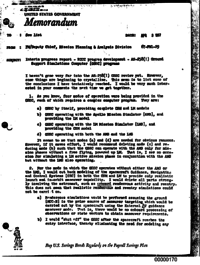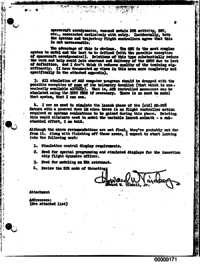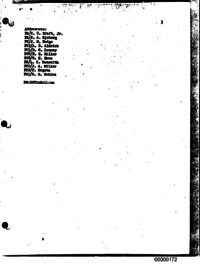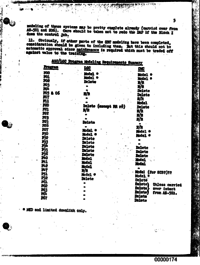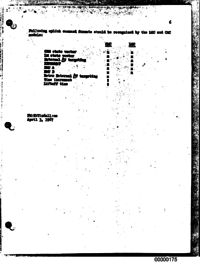See listAPR 3 196767-FM1-29FM/Deputy Chief, Mission Planning and Analysis DivisionInterim progress report – RTCC program development – AS-258(!) Ground Support Simulations Computer [GSSC] programs
I haven't gone very far into the AS-258(!) GSSC review yet. However, some things are beginning to crystallize. This memo is to list some of the conclusions I have tentatively reached. I would be very much inter- ested in your comments the next time we get together.
1. As you know, four modes of operation were being provided in the GSSC, each of which requires a complex computer program. They are:
a) GSSC by itself, providing complete CSM and LM models
b) GSSC operating with the Apollo Mission Simulator [AMS], and providing the LM model
c) GSSC operating with the LM Mission Simulator [LMS], and providing the CSM model
d) GSSC operating with both the AMS and the LMS
It seems to me that modes (a) and (d) are needed for obvious reasons. However, if it saves effort, I would recommend deleting mode (c) and re- ducing mode (b) such that the GSSC can operate with the AMS only for mis- sion phases without a free flying, powered up LM. That is, I see no occa- sion for simulating a LM active mission phase in conjunction with the AMS but without the LMS also operating.
2. For the mode in which the GSSC operates without either the AMS or the LMS, I would cut back modeling of the spacecraft Guidance, Navigation and Control Systems [GNC] in both the CSM and LM to provide only realistic launch and in-orbit maneuver capability. I would delete all parts strong- ly involving the astronaut, such as onboard rendezvous activity and reentry. This does not mean that realistic rendezvous and reentry simulations could not be carried on.
a) Rendezvous simulations would be performed assuming the ground [MCC-H] is the prime source of maneuver targeting which would be carried out by the spacecraft using the External ΔV guidance maneuver mode. That is, there would be no onboard processing of observations or state vectors to obtain maneuver requirements.
b) I would “shut off” the GSSC after the spacecraft reaches the entry interface, thereby eliminating the need for modeling any spacecraft aerodynamics, command module RCS activity, GNC, etc., associated exclusively with entry. Incidentally, both the systems and trajectory flight controllers agree that this is not unreasonable.
The advantage of this is obvious. The GNC is the most complex system to model and the last to be defined (with the possible exception of spacecraft aerodynamics!). Deletions of this type substantially reduce the work and help avoid late checkout and delivery of the GSSC due to lack of definition. And I don't think it reduces quality of the training sig- nificantly. (I have documented my views in this area more completely and specifically in the attached appendix).
3. All simulation of AGS computer programs should be dropped with the possible exception of some of its telemetry downlink (that which is con- veniently available already). That is, AGS controlled maneuvers can be simulated using the GSSC PNGS if necessary. There is no need to model that system, that I can see.
4. I see no need to simulate the launch phase of the (old) AS-208 Saturn with a powered down LM since there is no flight controller action required or systems evaluations to be gained during this phase. Deleting this would eliminate need to model the variable launch azimuth – a sub- stantial effort, I am told.
Although the above recommendations are not final, they're probably not far from it. Along with finishing off those areas, I expect to start looking into the following next:
1. Simulation control display requirements.
2. Need for special programming and simulated displays for the insertion ship flight dynamics officer.
3. Need for modeling an EVA astronaut.
4. Review the SCS mode of thrusting.
Enclosure
GSSC AS-258 Program Review Notes – Part 1 (GNC)
1. All simulation of AGS computer programs should be dropped with the possible exception of some of its telemetry downlink (that which is con- veniently available already). That is, AGS controlled maneuvers can be simulated using the GSSC PNGS if necessary. There is to need to model that system that I can see.
2. All state vectors, REFSMMAT's and targeting for maneuvers must come from the MCC-H (Mission Program) either by uplink or voice. This data should all be input to the GSSC in the most convenient way with no attempt at simulating the prethrust programs.
3. Offhand, I see no need for simulating spacecraft attitude except during maneuvers (if even that is necessary). It seems to me attitude changes can be made (for maneuver initialization) instantaneously.
4. By the same token, platform realignment should be carried out in- stantaneously based on the ground supplied REFSMMAT.
5. GSSC simulation can be stopped following execution of the retrofire maneuver except to continue state vector updating for tracking and telem- etry. Of course, if retrofire is unsuccessful the simulation should con- tinue on in orbit. The point is, there is no need to simulate the separa- tion maneuver and attitude changes (unless the AS-501 simulation is adequate for this). All reentry business should be deleted – digital autopilot, guidance, RCS thruster, aerodynamics, spacecraft sequences, etc. (This also applies to launch aborts).
6. All rendezvous targeting should be deleted, trajectory and telemetry to be carried out in same way as all other maneuvers. The single exception to this is to supply LM rendezvous radar range and range rate on the LGC downlink (no angles, no optics).
7. No spacecraft state vector updating (i.e., navigation) will be carried out using optics, spacecraft radar, etc. This had not been planned anyway. Of course, Average g integration is needed during maneuvers which does up- date the state vector.
8. Launch monitoring should be modeled for the AGC downlink including DSKY displays (these to be restricted to the nominal, standard format – not the entire pilot choice). None of the computations associated with crew monitoring of the launch vehicle should be included, such as Saturn poly- nomials, etc. That is, downlink should be constrained to be only those quantities used for the insertion GO-NO GO decision and subsequent action.
9. Standard coast-phase downlink should be modeled – at least to the extent that the data is easily available and useful. Things like “CDU desired” could be omitted since spacecraft attitude means nothing.
10. I guess there's no way of avoiding relatively complete modeling of the propulsion systems and associated guidance for SPS, DPS, APS, RCS man- euvers including attitude control. This is needed for realistic telemetry when the maneuvers occur over ground stations and realistic trajectory data when the burns are very long and over a site. Furthermore, I suppose modeling of these systems may be pretty complete already (carried over from AB-501 and 206). Care should be taken not to redo the DAP if the Block I does the control job.
11. Obviously, if other parts of the GNC modeling have been completed, consideration should be given to including them. But this should not be automatic approval since maintenance is required which must be traded off against value to the training.
AGC/LGC Program Modeling Requirements Summary Program LGC CMC P00 Model * Model * P01 Model * Model * P02 Delete N/R P03 – N/R P04 – Delete P05 & 06 N/R Delete P07 – N/R P11 – Model P20 Delete (except RR rṙ) Delete P21 N/R N/R P22 – N/R P23 – N/R P25 Delete – P26 – N/R P27 Model * Model * P30 Model * Model * P32 Delete – P33 Delete – P34 Delete Delete P35 Delete Delete P36 Delete Delete P40 Model Model P41 Model Model P42 Model – P47 N/R Model (for SCS?)?? P51 Model * Model * P52 Delete Delete P61 – Delete⎫ Unless carried P62 – Delete⎬ over intact P63 – Delete⎭ from AS-501. P64 – Delete P67 – Delete
* MED and limited downlink only.
Following uplink command formats should be recognized by the LGC and CMC models:
CMC LGC CSM state vector x x LM state vector x x External ΔV targeting x x REFSMMAT x x EMU A x x EMU B x x Retro External ΔV targeting x Time increment ? Liftoff time ?
- Apr 22, 1967 – Computer program requirements for AAP (12.0σ)

